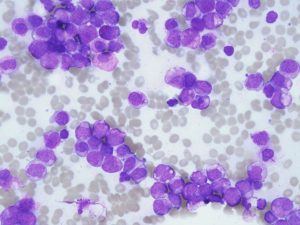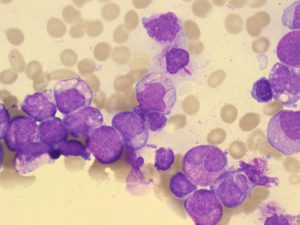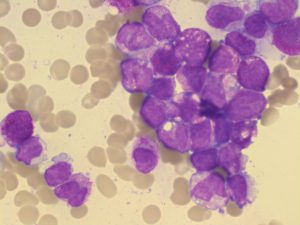74 Acute Promyelocytic Leukemia (APL)
Michelle To and Valentin Villatoro
- An image from a bone marrow smear demonstrating numerous myeloid precursors arrested at the promyelocyte stage, and cells with bundles of auer rods known as faggot cells in acute promyelocytic leukemia. 50x oil immersion. From MLS Collection, University of Alberta, https://doi.org/10.7939/R3WH2DW4D
- An image from a bone marrow smear showing faggot cells with bundles of auer rods seen in acute promyelocytic leukemia. 100x oil immersion. From MLS Collection, University of Alberta, https://doi.org/10.7939/R3N010854
- An image from a bone marrow smear showing faggot cells with bundles of auer rods seen in acute promyelocytic leukemia. 100x oil immersion. From MLS Collection, University of Alberta, https://doi.org/10.7939/R3H708G10
Note: APL is a subtype of AML where the promyelocytes specifically are affected. It is classified under the “AML with recurrent genetic abnormalities” and is associated with a specific genetic abnormality: t(15;17)(q22;q12); PML-RARA.
Affected Age:
Most often middle age adults, but APL can develop at any age,1,2
Affected Cell: 1
Promyelocyte
Cell Description:1,2
Nucleus: The shape of the nucleus is variable and can be bilobed, multilobed, indented, or folded. May demonstrate a typical “butterfly shape” appearance.
Cytoplasm: The hypergranular variant of APL is characterized by numerous promyelocytes with abundant abnormal, coarse, and dense granulation. The granules stain light pink to reddish-purple and heavily cover and obscure the nucleus of the cell. In the microgranular variant, the abnormal promyelocyte cells demonstrate a lack of granulation but often have abnormal bi-lobed nuclei.
Cells may contain characteristic multiple or bundles of auer rods (light pink) which the cells are then termed “Faggot cells.”
The granules in the neoplastic promyelocytes have procoagulant activity. Because of this, Disseminated Intravascular Coagulation (DIC) is associated as a complication of APL. Coagulation studies including fibrinogen and DDimer measurement can aid in the diagnosis of DIC in these patients.
References:
1. Bentley G, Leclair SJ. Acute Myeloid Leukemias. In: Clinical laboratory hematology. 3rd ed. New Jersey: Pearson; 2015. p. 500-21.
2. Swerdlow SH, Campo E, Harris NL, Jaffe ES, Pileri SA, Stein H, et al. editors. WHO Classification of Tumours of Haematopoietic and Lymphoid Tissues Volume 2. 4th ed. International Agency for Research on Cancer (IARC); 2008.




